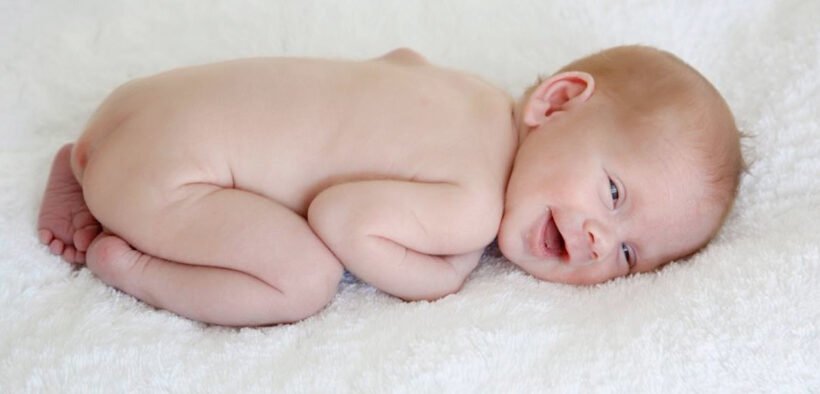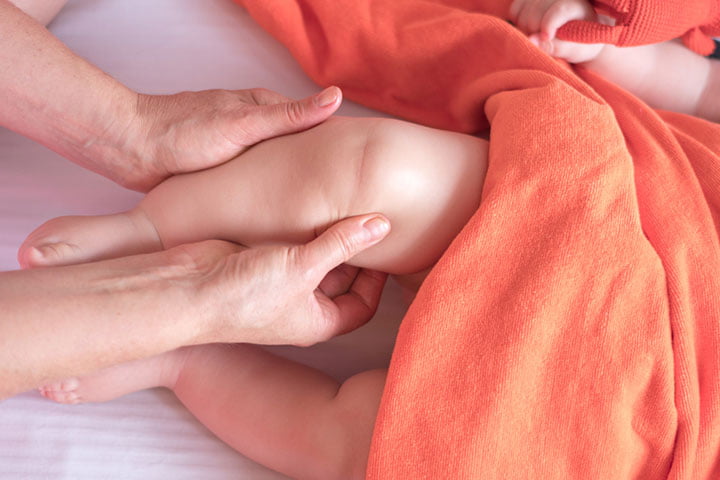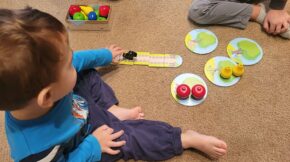When Do Babies Get Knee Caps?
Share

Have you ever noticed something about the babies? When toddlers try to run around the room, they often fall, but they never appear to break a bone or suffer serious injuries. For hours, they crawl, run, climb, and occasionally end up hurting their knees, but they quickly resume their activities. Do babies have soft knees? Do newborns have underdeveloped or no kneecaps? When do babies get kneecaps? Parents often question and wonder about these issues.
The experience of parenthood is filled with surprise and wonder and has endless learning as we watch our children grow and flourish. In the middle of this beautiful journey, there are a lot of confusing moments which make us wonder. This subject has confused parents and caregivers for a long time. Curiosity and worry have been both inspired by the idea that these small babies may lack an important skeleton part.
In this article, we are going on a scientific investigation to bust this long-standing misconception and reveal some fascinating truths about babies’ kneecaps.
Let’s explore the mysteries of newborn anatomy together and learn why the presence of kneecaps is more important than we may have ever realized.
The Myth of Missing Kneecaps

The misconception that newborns are born without kneecaps is most likely a result of the incomplete development of newborns’ kneecaps. The patellae, or kneecaps, are flat, circular bones that develop inside the quadriceps muscle tendon and serve as a fulcrum, enhancing the mechanical advantage of the muscle. The kneecaps of newborns are originally created from cartilage rather than solid bones.
So when Do Babies Get Kneecaps?
The kneecaps of newborns begin to form during the prenatal stage, but they do not fully ossify i.e., transform from cartilage to bone, until the child is between the ages of 2 and 6. Ossification is a process that gradually takes place as babies develop and become more physically active. Some people mistakenly believe that the kneecap is completely missing since the kneecap area feels soft to the touch and is not as noticeable as an adult’s kneecap.
But what exactly are the myths that surround the missing kneecaps in babies? Let’s find out.
The myth surrounding missing kneecaps is mostly based on the idea that babies are born without one in the first place. But that’s not all. Numerous other myths and misunderstandings accompany this myth.
Let us know what those misconceptions are.
- The most widely held misconception is that babies are born without kneecaps. Some people assume that kneecaps only develop as the child gets older because they think that babies’ legs are just soft and boneless where the knee should be.
- Another myth is that infants have delays in their kneecap development. Some people think that kneecaps develop over a period of years and that they don’t start to show up in the knees until they reach a particular age.
- Some people might believe that kneecaps suddenly appear after babies reach a particular age or a milestone in their development. This idea implies that kneecaps suddenly appear one day after being absent the day before.
- It is commonly believed that even if kneecaps form, they will always remain sensitive and prone to damage or injuries. It is possible for some to believe that even the smallest pressure or impact might damage a baby’s kneecaps.
- An associated myth states that infants do not have kneecaps when they crawl. Some people think that babies don’t need kneecaps when they’re crawling because they use their soft knees as cushions.
- It’s a common myth that kneecaps aren’t important until a baby is several months old and that they only start to matter as a youngster becomes older and more physically active.
To give precise details on babies’ kneecaps and their growth, it is important to bust these myths. Parents and other adults who are responsible for children’s early development can better care for, support, and handle their kids by being aware of the true nature of kneecap formation in newborns. Let’s learn about kneecaps in more detail.
The Truth About Kneecaps

We are aware of the common misconceptions regarding kneecaps, including the myth that babies are born without any kneecaps. But in reality, they do have kneecaps, but they are formed of cartilage and not bone. This is entirely acceptable, and it’s crucial for the development of the babies.
The flexible substance known as cartilage works to relax and soothe the joints. Babies, who are still learning to walk and crawl, this is important for those in particular. Their knees can move more easily thanks to the cartilage in their kneecaps, which also aids in preventing damage to their joints.
The cartilage in infants’ kneecaps eventually ossified, i.e., becomes bone, as they develop. This process often starts when a child is 2 years old and is finished by the time they are 10 or 12 years old.
Note: Consult your doctor if you have any worries regarding your child’s kneecaps. They can evaluate your baby’s growth and respond to injuries.
Here are some more facts about the kneecaps of the babies.
- The kneecap is the body’s largest sesamoid bone. Bones called sesamoid bones form inside tendons.
- The kneecap aids in preventing damage to the knee joint.
- The kneecap also aids in enhancing the knee joint’s range of motion.
- Over the course of childhood, the kneecap eventually ossifies i.e., changes into bones.
Why it Matters?

So why does it matter to have kneecaps made of cartilage in newborns? One benefit is that they are less likely to suffer knee injuries. Because cartilage is more flexible than bone, it can absorb shocks more effectively. A baby’s knee is less likely to be sprained or broken as a result of this.
Secondly, toddlers’ knees can move more freely thanks to the cartilage in their kneecaps. This is crucial for a baby’s growth since it teaches them how to crawl and walk.
So, when you see a baby’s knee the next time, don’t be shocked that it lacks a bony kneecap. That is perfectly acceptable. In reality, kneecaps made of cartilage are preferred for infants. They can move their knees more freely and are less prone to injury.
But that’s not all why it matters. Kneecaps are crucial for a number of reasons. It has several compelling reasons that have an impact on the child’s future as well. It’s important to know the truth regarding infants’ kneecaps for various reasons:
1. Peace of Mind for Parents
When they notice softness around their baby’s knees, many new parents may become frightened and mistakenly think something is wrong. You are frequently overwhelmed with joy and worry for the welfare of your child. It can be rather scary when you find that your baby’s knees feel soft and different from your own. It can bring much-needed peace of mind to understand that a baby’s softness is a typical stage of development. Unnecessary concerns about potential health problems or developmental issues can be reduced by understanding that the kneecaps are in the process of growing and will eventually become more solid bones.
2. Developmental Milestones
Parents, as well as caregivers, can accurately track their child’s developmental milestones by understanding the stages of skeletal development in infants. By keeping an eye on growth trends, any possible problems are dealt with right away.
Monitoring a baby’s developmental milestones is essential for evaluating their progress and making sure their physical development progresses according to their age. Parents and other adults who provide care for children can accurately monitor this particular milestone if they are aware of the kneecap’s progressive development.
For instance, a baby’s kneecaps should begin to show up on X-rays by the age of 6 months, and they should be fully ossified, i.e., convert to bone, by the time they are 2 to 6 years old. Monitoring these developmental milestones helps identify any possible skeletal problems early on, enabling quick medical intervention if necessary.
3. Pediatric Health
Knowing how a baby’s bones typically grow and develop can help you spot abnormalities or genetic conditions at an early stage. A child’s long-term health and well-being can be greatly impacted by early identification and management.
For those who offer healthcare to children, familiarity with typical growth patterns and developmental stages is crucial. Doctors can use this information to evaluate a child’s general development and spot any potential problems with bone growth or density. Early diagnosis of congenital disorders or developmental abnormalities can enhance a child’s long-term health and treatment outcomes.
4. Proper Handling
It can also affect how parents and other caregivers treat a baby’s kneecaps if they are aware of how delicate they are. When raising or playing with a baby, correctly supporting their knees might help avoid accidents. Babies are quite delicate, especially in the beginning. So it becomes crucial to make sure that their knees are correctly supported to help avoid accidents. Knowing how the kneecap is developing can help parents provide their children with the right amount of physical support and care, creating a secure and supportive environment for their development.
5. Education and Awareness
Promoting accurate knowledge within society depends on busting myths and misconceptions. We can promote a more knowledgeable and scientifically literate population by busting this widespread myth about kneecaps. Inaccurate care procedures or unjustified worries can result from misunderstandings. The ability to make decisions about their child’s health and well-being is given to parents through this knowledge.
Potential Issues
There is nothing to worry about, despite the fact that your baby’s kneecaps may appear to be more fragile and delicate than those of an older child. According to many doctors like Dr. Poinsett, a baby’s kneecaps are not more prone to injuries or health issues than a child’s kneecaps who is older.
Keep in mind that the kneecaps of your baby are supposed to be formed of flexible, soft cartilage. It makes sense why they appear to be able to crawl around unharmed and curl up into adorable tiny balls as babies.
Some doctors, like Dr. Airey, say that certain potential problems could arise during the change from baby knees to more mature knees. Specifically, a disease known as a bipartite patella may affect your growing child.
But what is a bipartite patella? The bipartite patella, according to Dr. Airey, is where the components haven’t fused entirely and result in a sort of “split” double kneecap develops in sections that fuse together during the time.
This may occasionally get better on its own or might be treated with physiotherapy. The most crucial thing is to keep an eye out for discomfort and swelling around your child’s knee because these symptoms may point to a knee problem, such as arthritis, or an injury to the tendons or ligaments.
Conclusion
In conclusion, kneecaps are not missing from birth in newborns. Although their kneecaps are cartilage rather than bone at birth and not fully grown, they will ossify naturally over the course of their first several years.
For parents to have peace of mind, to accurately track developmental milestones, to ensure pediatric health, to handle babies with care, and for further education and awareness, it is essential to understand the truth about babies and their kneecaps. Being knowledgeable about this part of a baby’s growth and development helps improve parenting techniques and help all children have a healthier and happier start in life. Being aware of when babies get kneecaps.
In order to offer their children the best care and support possible, parents and other caregivers must be informed about this element of a baby’s development. It also emphasizes how important accurate information transmission is in promoting a scientifically aware society.
Let us always seek the truth and eliminate myths that can confuse our understanding of nature’s careful design as we learn more about the marvels of the human body.















